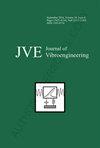Study of vibration frequency-fatigue strength action of 6061-T6 aluminum alloy during fillet welding
IF 0.7
Q4 ENGINEERING, MECHANICAL
引用次数: 0
Abstract
The research mainly focuses on the fatigue strength characteristics of 6061-T6 aluminum alloy fillet welds under different vibration frequencies. Firstly, by introducing Stress Life Curve (S-N Curve) and Probability Stress Life Curve (P-S-N Curve), the external vibration stress effects of the main load-bearing points in the stress environment of welded joints are analyzed. Subsequently, a vibration test control system is designed to analyze the relationship between vibration frequency and fatigue strength through nominal stress analysis and hot spot stress analysis. The research findings revealed that under the nominal stress analysis method, the P-S-N fitting curve showed a declining trend with an increase in fatigue life for stress variation curves with survival rates of 50 %, 95 %, and 97.7 % at vibration frequencies of 57.5 Hz, 67.5 Hz, and 77.5 Hz. At the same survival rate stress conditions, the fatigue life variation formed by resonance frequency was smaller, and the fatigue life in the resonance state was relatively lower. There is a certain correlation between vibration frequency and fatigue strength, with resonance frequency corresponding to relatively low fatigue life. This research result helps to reveal the fatigue behavior of 6061-T6 aluminum alloy fillet welds under different vibration stresses, providing a reference for the structural safety design of aluminum alloy components.6061-T6铝合金角焊振动频率疲劳强度作用研究
主要研究6061-T6铝合金角焊缝在不同振动频率下的疲劳强度特性。首先,通过引入应力-寿命曲线(S-N曲线)和概率应力-生命曲线(P-S-N曲线),分析了焊接接头应力环境中主要受力点的外部振动应力效应。随后,设计了振动试验控制系统,通过名义应力分析和热点应力分析,分析振动频率与疲劳强度之间的关系。研究结果表明,在标称应力分析方法下,应力变化曲线的P-S-N拟合曲线随着疲劳寿命的增加而呈下降趋势,在57.5Hz、67.5Hz和77.5Hz的振动频率下,存活率分别为50%、95%和97.7%,共振频率形成的疲劳寿命变化较小,共振状态下的疲劳寿命相对较低。振动频率与疲劳强度之间存在一定的相关性,共振频率对应相对较低的疲劳寿命。该研究结果有助于揭示6061-T6铝合金角焊缝在不同振动应力下的疲劳行为,为铝合金构件的结构安全设计提供参考。
本文章由计算机程序翻译,如有差异,请以英文原文为准。
求助全文
约1分钟内获得全文
求助全文
来源期刊

Journal of Vibroengineering
工程技术-工程:机械
CiteScore
1.70
自引率
0.00%
发文量
97
审稿时长
4.5 months
期刊介绍:
Journal of VIBROENGINEERING (JVE) ISSN 1392-8716 is a prestigious peer reviewed International Journal specializing in theoretical and practical aspects of Vibration Engineering. It is indexed in ESCI and other major databases. Published every 1.5 months (8 times yearly), the journal attracts attention from the International Engineering Community.
 求助内容:
求助内容: 应助结果提醒方式:
应助结果提醒方式:


